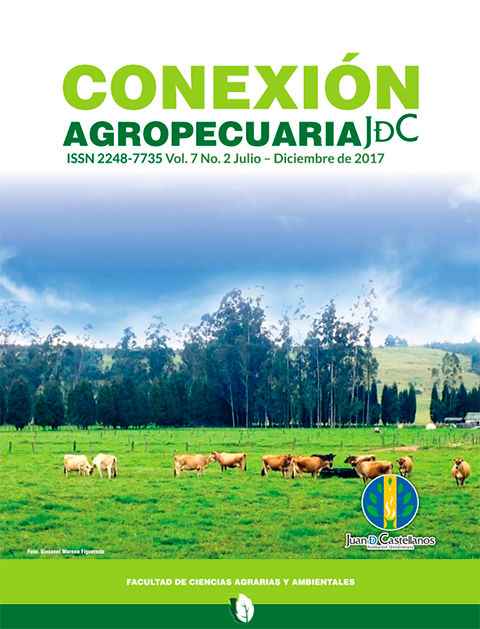Palabras clave:
aborto, embrionaria, inmunohistoquímica, inmunofluorescencia, PCR, reabsorciónResumen
La campylobacteriosis genital bovina es una enfermedad venérea de los bovinos de distribución mundial, que causa grandes pérdidas económicas en las ganaderías, sus agentes etiológicos son Campylobacter fetus fetus que ocasiona infecciones del tracto digestivo de ovinos y bovinos, y campylobacter fetus veneralis que se aloja en el tracto reproductivo de hembras y machos. Entre los factores de riesgo, se encuentra la monta directa, presencia de pequeños rumiantes en las ganaderías y el no cumplimiento de las medidas de bioseguridad. Esta enfermedad es asintomática en los toros, pero en las hembras ocasiona disminución en la tasa de preñez, abortos y muerte embrionaria. El aislamiento de la bacteria es el método más efectivo para la identificación de las subespecies de Campylobacter fetus, pero es una técnica que conlleva tiempo y trabajo, debido a sus altos requerimientos y desarrollo lento. La inmunofluorescencia, la inmunohistoquímica y la reacción en cadena de la polimerasa, son técnicas que actualmente mejoran su identificación, ya que poseen una alta especificidad y sensibilidad a Campylobacter fetus, optimizando la evaluación de poblaciones bovinas con alta densidad. El propósito de la revisión, es describir los métodos actuales para la identificación de la enfermedad en la ganadería bovina, y así poder tomar medidas preventivas y curativas para el control de esta patología.
Descargas
Citas
AGISTIANA, S., SETIYANINGSIH, S., E INDRAWATI, A. (2018). Application of Multiplex PCR Assay for Campylobacter fetus Sub sp. Detection and Differentiation in Bovine Preputial Wash. Buletin Peternakan, 42(1), 1-7. Doi: 10.21059/buletinpeternak.v42i1.26114.
ALI, A., SOARES, S., SANTOS, A., GUIMARÃES, L., BARBOSA, et al. (2012). Campylobacter fetus subspecies: Comparative genomics and prediction of potential virulence targets. Gene, 508, 145-156.
BESSEDE, E., SOLECKI, O., SIFRE, E., LABADI, L., Y MEGRAUD, F. (2011). Identification of Campylobacter species and related organisms by matrix assisted laser desorption ionization-time of flight (MALDI-TOF) mass spectrometry. Clinical Microbiology and Infection, (17), 1735-1739.
BLASER, M., NEWELL, D., THOMPSON, S., Y ZECHNER, E. (2008). Pathogenesis of Campylobacter fetus. En: Nachamkin I., Szymanski C.M., y Blaser M.J. (Eds.), Campylobacter (3.a ed.) (pp. 401-428). Washington: ASM.
CAMPERO, C.M., ANDERSON, M.L., WALKER, R.L., BLANCHARD, P.C., BARBANO, L. & CHIU, P. (2005). Immunohistochemical identification of Campylobacter fetus in natural cases of bovine and ovine abortions. J Vet Med., 52, 138-141.
CARTER, G.R. (1979). Campylobacter and Vibrio. En: Carter, G. (ed.), Diagnostic procedures in veterinary bacteriology and micology (3.a ed.) (pp. 53-62). Illinois: Charles C. Thomas Publisher.
CHABAN, B., CHU, S., HENDRICK, S., WALDNER, C., Y HILL, J.E. (2012). Evaluation of a Campylobacter fetus subspecies venerealis real-time quantitative polymerase chain reaction for direct analysis of bovine preputial samples. Can J Vet Res., 76, 166-173.
CIPOLLA, A.L., CAMPERO, C.M., CANO DE MEDINA, D., MORSELLA, C., COSENTINO, B., Y CARACINO, M. (1995). Un método mejorado para el diagnóstico de la campylobacteriosis genital en vacas. Revista Argentina de Producción Animal, 15, 742-5.
CORNEJO, A., SERRATO, A., RONDÓN, B., Y ROCHA, M. (2014). Herramientas moleculares aplicadas en ecología: Aspectos teóricos y prácticos. México: Secretaría de Medio Ambiente y Recursos Naturales.
DENIS, F., CECILE, M., MARTIN, C., BINGEN, E., Y QUENTIN, R. (2011). Bactériologie médicale: Techniques usuelles.
FERNÁNDEZ, M.E., CAMPERO, C.M., MORRELL, E., CANTÓN, G.J., MOORE, D.P., et al. (2007). Pérdidas reproductivas en bovinos causadas por abortos, muertes prematuras, natimortos y neonatos: casuística del período 2006-2007. Argentina. Revista de Medicina Veterinaria, 88, 246-54.
FIORENTINO, A., STAZIONATI, M., HECKER, Y., MORSELLA, C., CANTÓN, G., et al. (2017). Campylobacter fetus subsp. fetus ovine abortion outbreak in Argentina. Revista electrónica de Veterinaria, 18(11).
FIORENTINO, M., PAOLICCHI, F., CAMPERO, C., Y BARBEITO, C. (2018). Lectin binding patterns and immunohistochemical antigen detection in placenta and lungs of Brucella abortus-bovine infected fetuses. Open Veterinary Journal, 8(1), 57-63.
FREY, C., MÜLLER, N., STÄUBER, N., MARREROSA, N., HOFMANN, L., HENTRICH, B. & HIRSBRUNNER, G. (2017). Simplicimonas-like DNA in vaginal swabs of cows and heiferscross-reacting in the real-time PCR for T. foetus. Veterinary Parasitology, 237, 30-36. doi: 10.1016/j.vetpar.2017.02.024
GARCÍA, V., Y LEGARRAGA, P. (2017). Campylobacter fetus. Revista Chilena de Infectología, 34(6), 587-588.
GIRALDO, J. (2007). Una Mirada al uso de la inseminación artificial en bovinos. Revista Lasallista de investigación, 4, 51-57.
GIVENS, D., Y MARLEY, M. (2008). Pathogens that cause infertility of bulls or transmission via semen. Theriogenology, 70, 504-507.
GORKIEWICZ, G., KIENESBERGER, S., SCHOBER, C., SCHEICHER, S., GULLY, C., ZECHNER, R., Y ZECHNER, E. (2010). A genomic island defines Subspecies-specific virulence features of the host-adapted pathogen Campylobacter fetus subspecies venerealis. Journal of Bacteriology, 192, 502-517.
GORKIEWICZ, G., KIENESBERGER, S., SCHOBER, C., SCHEICHER, S.R., GULLY, C., Y ZECHNER, R. (2010). A genomic island defines subspecies-specific virulence features of the host-adapted pathogen Campylobacter fetus subsp. venerealis. Journal of Bacteriology, 192, 502-17.
GRAAF-VAN, B.L., DUIM, B., MILLER, W., FORBES, K., WAGENAAR, J., Y ZOMER, A. (2016). Whole genome sequence analysis indicates recent diversification of mammalassociated Campylobacter fetus and implicates a genetic factor associated with H2S production. BMC Genomics, 17, 713.
GRAAF-VAN, B.L., VAN BERGEN, M.A., VAN DER WAL, F.J., DE BOER, A.G., DUIM, B., Y SCHMIDT, T. (2013). Evaluation of molecular assays for identification Campylobacter fetus species and subspecies and development of a Campylobacter fetus specific real-time PCR assay. J Microbiol Methods, 95, 93-7.
HANCOCK, A., YOUNIS, P., BEGGS, D., MANSELL, P., STEVENSON, M., Y PYMAN, M. (2016). An assessment of dairy herd bulls in southern Australia: 1.
Management practices and bull breeding soundness evaluations. J. Dairy Sci., 99, 1-15.
HUM, S., BRUNNER, J., MCINNES, A., MENDOZA, G., Y STEPHENS, J. (1994). Evaluation of cultural methods and selective media for the isolation of Campylobacter fetus subesp. venerealis from cattle. Australian Veterinary Journal, (71), 184-186.
HUM, S., QUINN, K., BRUNNER, J. & ON, S.L. (1997). Evaluation of a PCR assay for identification and differentiation of Campylobacter fetus subspecies. Australian Veterinary Journal, (75), 827-831.
IRAOLA, G., BETANCOR, L., CALLEROS, L., GADEA, P., ALGORTA, G., GALEANO, S., MUXI, P., GREIF, G., Y PÉREZ, R. (2015). A rural worker infected with a bovine-prevalent genotype of Campylobacter fetus subesp. fetus supports zoonotic transmission and inconsistency of MLST and whole-genome typing. European Journal of Clinical Microbiology & Infectious Diseases, (34), 1593-1596.
IRAOLA, G., HERNÁNDEZ, M., CALLEROS, L., PAOLICCHI, F., SILVEYRA, S., Y VELILLA, A. (2012). Application of a multiplex PCR assay for Campylobacter fetus detection and subspecies differentiation in uncultured samples of aborted bovine fetuses. Journal of Veterinary Science, 13, 371-6.
JIMÉNEZ, D., PÉREZ, A., CARPENTER, T. & MARTÍNEZ, A. (2011). Factors associated with infection by Campylobacter fetus in beef herds in the Province of Buenos Aires, Argentina. Argentina, (101), 157-162.
KIENESBERGER, S., GORKIEWICZ, G., JOAINIG, M., SCHEICHER, S., LEITNER, E., Y ZECHNER, E. (2007). Development of Experimental Genetic Tools for Campylobacter fetus. American Society for Microbiology. Applied and environmental Microbiology, 4619-4630.
KIENESBERGER, S., SPRENGER, H., WOLFGRUBER, S., HALWACHS, B., THALLINGER, G., Y PÉREZ, G.I. (2014). Comparative genome analysis of Campylobacter fetus subspecies revealed horizontally acquired genetic elements important for virulence and niche specificity. Plos One, 9(1). doi: 10.1371/journal.pone.0085491
LARSON, R., Y WHITE, B. (2016). Evaluating Information Obtained from Diagnosis of Pregnancy Status of Beef Herds.
MAHAJAN, V., HARMANJIT, B., Y ANIL, G. (2014). Immunohistochemical and Molecular Approaches for the Diagnosis of Campylobacter fetus subsp. venerealis in Natural Cases of Bovine Abortion. The National Academy of Sciences, 85(2). Doi: 10.1007/s40011-014-0369-9.
MAI, H., IRONS, P., KABIR, J., Y THOMPSON, P. (2012). A large seroprevalence survey of brucellosis in cattle herds under diverse production systems in Northern Nigeria. BMC Vet. Res., 8(144).
MAI, H., IRONS, P., KABIR, J., Y THOMPSON, P. (2013). Herd-level risk factors for Campylobacter fetus infection, Brucella seropositivity and within-herd seroprevalence of brucellosis in cattle in northern Nigeria. Prev Vet Med., 111(3-4), 256-67. doi: 10.1016/j.prevetmed.2013.05.016
MANES, J., FIORENTINO, M., SAN MARTINO, S., Y UNGERFELD, R. (2017). Changes in the vaginal microbiota in ewes after insertion of intravaginal sponges at different stages of the oestrous cycle. Livestock Science, 208, 55-59. Doi: https://doi.org/10.1016/j.livsci.2017.11.023.
MARCELLINO, R., MORSELLAB, C., CANOB, D., Y PAOLICCHIB, F. (2015). Eficiencia del cultivo bacteriológico y de la inmunofluorescencia en la detección de Campylobacter fetus en fluidos genitales bovinos. Revista Argentina de Microbiología, 47(3), 183-189.
MCGOLDRICK, A., CHANTER, J., GALE, S., PARR, J., TOSZEGHY, M., Y LINE, K. (2013). Real Time PCR to detect and differentiate Campylobacter fetus subspecies fetus and Campylobacter fetus Subspecies venerealis. Journal of Microbiology Methods, 94, 199-204.
MCMILLEN, L., FORDYCE, G., DOOGAN, V.J., Y LEW, A.E. (2006). Comparison of culture and a novel 5’ Taq nuclease assay for direct detection of Campylobacter fetus subesp. venerealis in clinical specimens from cattle. Journal of Clinical Microbiology, 44, 938-945.
Méndez, D., Góngora, A., y Gómez, L. (2014). Aislamiento e identificación de la flora bacteriana uterina en vacas donantes de embriones. Orinoquia, 18(1), 86-91.
Michi, A., Favetto, P., Kastelic, J., y Cobo, E. (2015). A review of sexually transmitted bovine trichomoniasis and campylobacteriosis affecting cattle reproductive health. Theriogenology, 85(5), 781-791. Doi: 10.1016/j.theriogenology.2015.10.037.
Monke, H.J., Love, B.C., Wittum, T.E., Monke, D.R., y Byrum, B.A. (2002). Effect of transport enrichment medium, transport time, and growth medium on the detection of Campylobacter fetus subsp. venerealis. Journal of Veterinary Diagnostic Investigation, 14, 35-9.
Morrell, E.L., Barbeito, C.G., Odeo´N, C.A., Gimeno, E.J. & Campero, C.M. (2011). Histopathological, immunohistochemical, lectinhistochemical and molecular findings in spontaneous bovine abortions by Campylobacter fetus. Reprod Domest Anim., 46, 309-315.
Mshelia, G., Amin, J., Egwu, G., Yavari, C., Murray, R., y Woldehiwet, Z. (2010). Detection of antibodies specific to Campylobacter fetus subsp. venerealis in the vaginal mucus of Nigerian breeding cows. Veterinaria Italiana, 46, 337-344.
OIE. (2017). Manual terrestre OIE 2017: Campylobacteriosis genital bovina. Recuperado de http://www.oie.int/fileadmin/Home/esp/Health_standards/tahm/2.04.04_Campilobact_bovina.pdf. Consultado en: 15/ 05/ 18.
OIE. (2008). Bovine genital campylobacteriosis and Trichomonosis. World Organization for Animal Health. Recuperado de http://www.oie.int/wahis/public.php?page=disease_timelines.
PEÑA, M., GÓNGORA, A., Y JIMÉNEZ, C. (2011). Infectious agents affecting fertility of bulls, and transmission risk through semen. Retrospective analysis of their sanitary status in Colombia. Colombia. Revista Colombiana de Ciencias Pecuarias, 24, 634-646.
SALAMA, S.M., GARCÍA, M.M., Y TAYLOR, D.E. (1992). Differentiation of the subspecies of Campylobacter fetus by genomic sizing. Int. J. Syst. Bact., (42), 446-450.
TUCUZ, M., ORUC, E., TUCUZ, N., YOLDAS A., Y YIGIN, A. (2010). Diagnosis of Campylobacteriosis in the aborted bovine fetuses by pathological, immunohistochemical, microbiological and real time PCR. Journal of the Faculty of Veterinary Medicine, Kafkas University, 16, 509-514.
VAN BERGEN, M., DINGLE, K.E., MAIDEN, M.C., NEWELL, D.G., GRAFF-VAN B.L., VAN PUTTEN, J.P., Y WAGENAAR, J.A. (2005). Clonal nature of Campylobacter fetus as defined by multilocus sequence typing. Journal of Clinical Microbiology, 43, 5888-5898.
VANDAMME, P. (2000). Taxonomy of the family Campylobacteraceae. In: Nachamking N. y Blaser M.J. (Eds.), Campylobacter. (2.a ed.) (pp. 3-20). Washington: American Society for Microbiology.
WAGENAAR, J.A., VAN BERGEN, M.A., NEWELL, D.G., GROGONO-THOMAS, R., Y DUIM, B. (2001). Comparative study using amplified fragment length polymorphism fingerprinting and phenotyping to differentiate Campylobacter fetus strains isolated from animals. Journal of Clinical Microbiology, (39), 2283-2286.
WANG, G., CLARK, C.G., TAYLOR, T.M., PUCKNELL, C., BARTON, C., PRICE, L., WOODWARD, D.L., Y RODGERS, F.G. (2002). Colony multiplex PCR assay for the identification and differentiation of Campylobacter jejuni, C. coli, C. lari, C. upsaliensis, and C. fetus subesp. fetus. J. Journal of Clinical Microbiology, 40, 4744-4747.
WINN, W., ALLEN, S., JANDA, W, KONEMAN, E., PROCOP, G., SCHRECKENBERGER, P., Y WOODS, G. (2008). Diagnóstico microbiológico: bacilos gramnegativos curvos y fermentadores de oxidasa positivos (6.a ed.). España: Panamericana.
YÁBAR, C. (2003). Manual de procedimientos de electroforesis para proteínas y ADN. Perú: Instituto Nacional de Salud.





